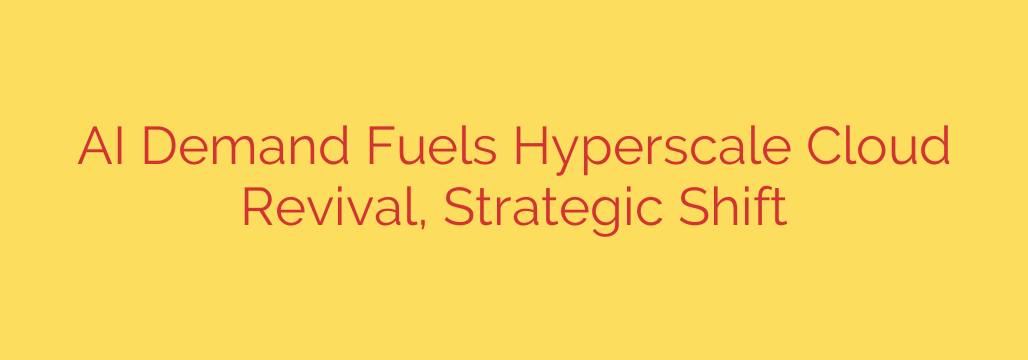
AI’s Insatiable Demand: Fueling a New Era of Hyperscale Cloud Growth
After a period where “cloud cost optimization” was the dominant theme in boardrooms and IT departments, the tide is turning dramatically. The explosive growth of artificial intelligence, particularly generative AI, is triggering a massive new wave of investment, breathing new life into the hyperscale cloud market and forcing a strategic rethink for businesses everywhere.
The slowdown in cloud spending seen over the past year is officially over. We are now witnessing a dramatic rebound in cloud spending, driven almost entirely by the computational demands of AI. This isn’t just a minor uptick; it’s a fundamental shift in how companies view and use cloud infrastructure.
From Cost-Cutting to Capacity-Building: The AI Effect
Just a short time ago, enterprises were focused on trimming their cloud bills, rightsizing instances, and maximizing the efficiency of their existing cloud environments. Today, that narrative is being replaced by an urgent need to secure the massive computing power required to train, fine-tune, and run sophisticated AI models.
The reality is that building and operating generative AI is an incredibly resource-intensive endeavor. It requires a scale of processing power that is beyond the reach of all but the largest corporations. This has made the public cloud an indispensable partner for any organization serious about leveraging AI. As a result, the major cloud providers are seeing their growth re-accelerate as customers rush to build out their AI capabilities.
Why AI Workloads are Different (and More Expensive)
The key driver behind this surge is the need for highly specialized and powerful hardware. Unlike general-purpose computing tasks, AI workloads, especially the training of Large Language Models (LLMs), rely heavily on graphics processing units (GPUs).
Here’s what makes AI infrastructure unique:
- Massive Parallel Processing: AI models require thousands of processors working in tandem, making them a perfect fit for the massive, distributed architecture of the public cloud.
- Dependence on Specialized Chips: The demand for high-end NVIDIA GPUs has skyrocketed, creating a new kind of “arms race” among cloud providers to secure a sufficient supply of this critical hardware.
- Huge Capital Investment: Building and maintaining data centers filled with these expensive, power-hungry GPUs requires billions of dollars in capital expenditure—an investment that cloud giants like Amazon Web Services (AWS), Microsoft Azure, and Google Cloud Platform (GCP) are uniquely positioned to make.
This shift means that cloud providers are no longer just competing on storage costs or virtual machine pricing. The new battleground is who can offer the most powerful, readily available, and scalable AI infrastructure.
What This Means for Your Business: A Strategic Imperative
The resurgence of the cloud, powered by AI, has significant implications for businesses of all sizes. Navigating this new landscape requires a strategic approach that goes beyond simple technology adoption.
Here are four key considerations for business leaders:
Embrace Strategic Cloud Investment: It’s time to stop viewing the cloud as a mere cost center and start seeing it as a strategic enabler for innovation. Access to world-class AI infrastructure through the cloud is not a luxury; it’s a competitive necessity for staying relevant. Your budget should reflect this new reality.
Prepare for a New Cost Structure: AI workloads are expensive. Be prepared for cloud spending to increase as your organization adopts AI more deeply. However, this spending should be directly tied to business value, such as developing new products, enhancing customer experiences, or automating complex processes.
Prioritize Workload Optimization: Simply throwing money at the cloud is not a sustainable strategy. It’s crucial to focus on optimizing AI workloads for both performance and cost. This includes selecting the right model sizes, choosing the most efficient hardware instances for specific tasks (training vs. inference), and implementing FinOps principles for AI.
Double Down on Data Security and Governance: AI models are only as good as the data they are trained on. As you move more data to the cloud to fuel your AI initiatives, data security and governance become more critical than ever. Ensure you have robust policies and technical controls in place to protect sensitive information throughout its lifecycle, from storage and processing to model training and deployment.
The era of AI is inextricably linked to the power and scale of the cloud. The companies that understand this connection and strategically invest in the right infrastructure and expertise will be the ones that lead the next wave of technological innovation.
Source: https://datacenterpost.com/hyperscale-cloud-rebounds-on-ai-demand-strategic-reset/








